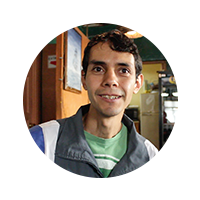"Omar was thirty-eight years old and was a coordinator of the committee for two years and a half by the time I met him."
In October 2012, on a Tuesday, some posters were hanging on the walls of the neighbourhood. During the last years
there has been a proliferation of cafes, restaurants and bars and this area has become trendy for middle to high classes.
Some of the owners of these places have put tables and chairs on the pavement to create an outside area for their customers.
During the night, bars and clubs, popularly known as antros, play their music while offering a place to have a drink. However,
many residents have resented these practices, arguing that restaurants and cafes invade the pedestrian path and antros produce
a high amount of noise, not only occasioned by music but also by some of the drunk people that come out of these places.
The situation became more serious with the explosion of real state in the area. A ten floor-building project that included a
shopping center started a couples of months ago which violates the restrictions of the use of the land, given its delicate state.
This neighbourhood was constructed on soft ground given the close proximity the water table and residents argue that the water
supply system will not have the capacity to sustain such amount of flats.
Residents of this area have made use of their committees in order to tackle these problems. These committees, called Comités Ciudadanos,
are the main link between the citizens and the government, particularly the delegates of each borough. They represent the collective
interests of the residents of each neighbourhood in the city. Nine residents elected by vote every three years coordinate each committee.
Omar is one of these coordinators.
Omar was thirty-eight years old and was a coordinator of the committee for two years and a half by the time I met him. I met Omar through
Roberto in a meeting where Roberto expressed the support of the tianguis association to the committee in regards to the problem of the
proliferation of restaurants and non-regulated real state construction. For street vendors a shopping centre would eventually mean eviction.
Although the committees are not governed by a hierarchical system, participation and involvement will depend on time,
resources and capacities available of the coordinators. This often means overload of work for those who have a more flexible work timetable,
those who are young enough for heavy duties, such as loading equipment during events and walking long distances to attach posters
and distribute leaflets, and those enthusiastic enough to continually participate. Omar does not receive resources destined to
fulfil committee duties. Thus, some residents chip in by giving him, for example, mobile credit to make the required calls to
authorities or collaborate with travel expenses.




